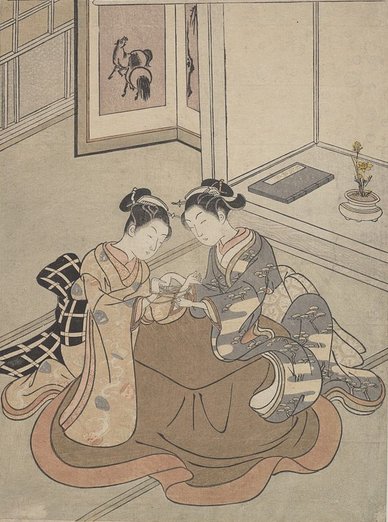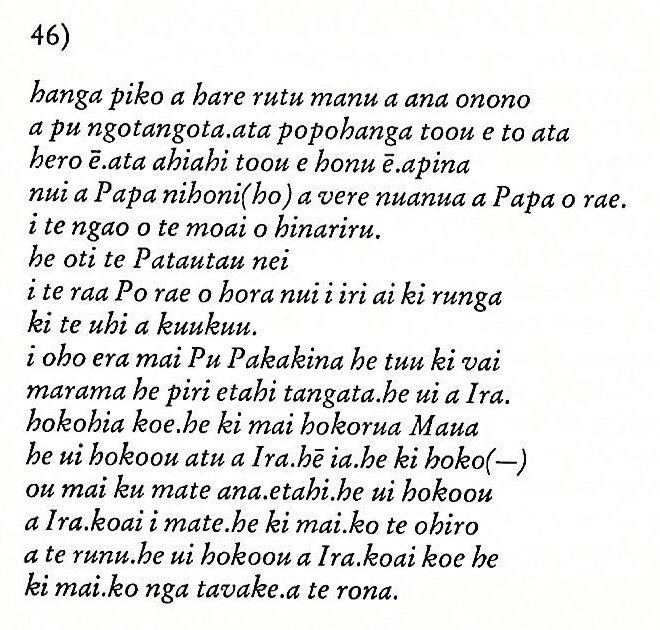The string figures - which presumably together were creating the outline of 'the
cradle of the cat'

- ended at Apina Nui (he oti
te Pautautau nei) and this place clearly coincided with the heliacal
star Al Tarf (The End):
Oti. To come to an
end; to suffice, to be enough: ku-oti-á, it is finished;
ina kai oti mo kai, there is not enough to eat; he-oti
á, there isn't anymore left, it's the last one; it's enough
with that. Vanaga. Ta.: 1. Oti, presage of death. Sa.:
oti, to die. 2. To cut. Mq.: koti, oti, id.
Sa.: 'oti, id. Ma.: koti, id. Churchill.
... hakatautau, to append. P Pau.: fakatautau, to
hang up. Mq.: tautau, id. Ta.: faatautau, id. ...
kau-kau, to take counsel, to resolve, to chide, to
reprove, to explain, make clear ... tau-tau, to hang,
hang up ...
Pau. 1. To run out
(food, water): ekó pau te kai, te vai, is said when there
is an abundance of food or water, and there is no fear of
running out. Puna pau, a small natural well near the
quarry where the 'hats' (pukao) were made; it was so
called because only a little water could be drawn from it every
day and it ran dry very soon. 2. Va'e pau, clubfoot.
Paupau: Curved. Vanaga. 1. Hakapau, to pierce (cf.
takapau, to thrust into). Pau.: pau, a cut, a
wound, bruised, black and blue. 2. Resin. Mq.: epau,
resin. Ta.: tepau, gum, pitch, resin. (Paupau)
Hakapaupau, grimace, ironry, to grin. 3. Paura
(powder), gunpowder. 4. Pau.: paupau, breathless. Ta.:
paupau, id. 5. Ta.: pau, consumed, expended. Sa.:
pau, to come to an end. Ma.: pau, finished. 6. Ta.:
pau, to wet one another. Mq.: pau, to moisten.
Churchill. Paua
or
pāua
is the Māori name given to three species of large edible
sea snails, marine gastropod molluscs which belong to the family
Haliotidae (genus Haliotis), known in the USA as
abalone, and in the UK as ormer shells ... Wikipedia
|
MAY
14 |
15
(365 + 135 = 500) |
16
(136) |
17 |
18 (*58 = 2 * 29) |
19 |
 |
 |
 |
 |
 |
 |
|
Ga2-24 |
Ga2-25 |
Ga2-26 |
Ga2-27 (57) |
Ga2-28 |
Ga2-29 |
|
φ Gemini (118.4)
*77.0 = *118.4 - *41.4 |
DRUS
(Hard) = χ Carinae
(119.9) |
ω
Cancri (120.2) |
8h (121.7)
χ Gemini (121.0),
NAOS
= ζ Puppis
(121.3) |
ρ
Puppis (122.0),
HEAP OF FUEL
= μ Cancri
(122.1),
ζ
Monocerotis (122.3), ψ
Cancri (122.6),
REGOR (Roger backwards) = γ Velorum
(122.7) |
TEGMINE = ζ Cancri
(123.3) |
|
July
17 |
18 |
19
(200) |
20
(*121) |
21 |
22 /
7 |
|
°July 13 |
14 |
15
(196) |
16 |
17
(*118 = 4 * 29½) |
18 |
|
'June 20 |
SOLSTICE |
22
(173) |
23 |
ST JOHN'S DAY |
25 (*96) |
|
"June 6 |
7 |
8 |
9
(*80) |
Te Maro 10
(161) |
11 |
|
he ea.a Ira.he iri he oho ki runga anake.
i
te angahuru o te raa o te maro i iri ai -
Ira got
up. They all climbed to the top of the hill.
They climbed up on the
tenth day of the month of June ('Maro’).
(E:18) |
|
DAY
118 - 64 = 54
54
Vai Rapa
a
haka remereme |
31 + 24 = 55 |
56 (Sic!) Te
Vai Rutu Manu
a
koro rupa e haho e hivi e e runga e te puku ohu
kahi e |
57 Hanga Piko
(Curved Bay)
a
hare utu manu a ana onoono a pu ngotangota |
58 Ata
Popohanga (Morning Shadow)
toou
e to ata
hero ē |
59 Ata Ahiahi
(Evening Shadow)
toou
e honu ē |
|
... The leap day was introduced as part of the
Julian reform. The day following the Terminalia
(February 23) was doubled, forming the 'bis
sextum - literally 'double sixth', since
February 24 was 'the sixth day before the
Kalends of March' using Roman inclusive counting
(March 1 was the 'first day').
Although exceptions exist,
the first day of the bis sextum (February
24) was usually regarded as the intercalated or
'bissextile' day since the third century.
February 29 came to be regarded as the leap day
when the Roman system of numbering days was
replaced by sequential numbering in the late
Middle Ages
... |
E:46 |
|
1 Ko Apina Iti |
27 |
29 Ko Te Rano A Raraku |
(30) |
|
29 |
|
30 |
|
31 Oparingi |
11 |
(43) |
1 |
45 Vai ngaere |
8 |
54 Vai Rapa |
(55) |
4 |
60 Apina Nui |
|
12 |
11 |
5 |
|
24 |
|
|
... The
'watering place' where the bird beats (the
rhythm)' - wordplay, 'where a certain chant is
being recited' - is located near Hanga Piko. A
recitation provides the following information
for the additional name: 'In Koro Rupa is the
house where one is made to laugh; in Kere Mea is
the house where one is made fun of' (Barthel
1960:851; Campbell 1971:400). There the rule of
the new birdman was celebrated (compare koro
'feast'). In RAP., koro rupa seems to
have the same meaning as in TUA. kororupo,
which describes a paradise. In the cosmology of
the TUA., the name also referred to the entrance
to the underworld. Hivi (maybe the same
as hi ivi 'to fish with a hook made from
bone'; compare the narrative ME:363) is
'outside', and 'the elevation from where (the
catch of) the tunafish is announced' is 'above'.
This is a reference to a large boulder beside
the place where the canoes docked in Hanga Piko.
There the people waited for the canoes to return
from the fishing grounds.
'Curved Bay',
the well-known little harbour on the western
shore, is linked with a 'house where the bird
beats (the rhythm), that is, where a certain
chant is being recited. This establishes a
cross-connection to the watering place by the
same name and also to the 'Koro Rupa' motif and
the theme of the birdman cult. It also suggests
the newly discovered petroglyphs from Hanga Piko
(so far, only partially published by Barthel
1962:Illustration 2). Ana Onoono is a cave
well-suited as an overnight shelter; Pu
Ngotangota is a coastal formation where seawater
is allowed to flow in and out. The three
additions, 'house', 'cave', and 'hole', always
describe an enclosed area.
'Yours is the morning shadow' refers to an area
in Ata Hero where the house of Ricardo Hero is
now located. 'Yours is the evening shadow'
belongs to a 'turtle'. I could not obtain any
information about the location, but I suspect
that the 'turtle' refers to a motif in the
narration of Tuki Hakahevari (the turtle is
carved in stone in a cave along the bay of
Apina) ... (The
Eighth Land, pp. 89-90.) |
|
Kere. To moor, to make
fast. Kerekere, black, dark, blue,
obscure, gloom; niho kerekere, blackened
teeth. Hakakerekere, to blacken. P Pau.:
kerekere, black, dark, somber. Mgv.:
kerekere, blue, dark blue almost black, the
color of the deep ocean, black, somber,
darkness. Mq.: kerekere, keékeé,
black, somber, livid; ere, blue, azure.
Ta.: ereere, black. Churchill.
ELE¹,
v. Haw., be dark, black; adj.
dark-coloured, black, blue, dark-red, brown;
ele-ele, id. Tah., ere-ere, dark,
black, blue. Rarot., kerekere, id.
Marqu., kekee, id.; kee-voo,
darkness, gloom. The application of this word to
colour is doubtless derivative from the Polynes.
Haw. kele, mud, mire (quod vide),
Tong. kèle-kere, earth, soil, dirt, Sam.
'ele and 'ele-ele, red earth, dirt,
rust; elea, Tong., kelea, rusty,
dirty; probably all akin to ala, ara,
in ala-ea, earth, clay ... Jav., iran,
black. N. Celebes (Kema), hirun, id. In
the following Greek words the first constituent
proclaims their affinity to the Polynesian
ere, ele: -
ερεβος,
darkness of the grave, the dark passage from
earth to Hades; ερεβεννος, dark, gloomy;
ερεμνος, sync. fr. previous word, black,
swarthy; ερεφω, to cover; ορφνη,
darkness of night; ορφνος, dark, dusty;
οροφη, roof of a house. Sanskr.,
aruņa,
tawny, dark, red; s.
the dawn, the sun; aruņita,
made red. Benfey refers the Sanskrit word to
arus,
a wound. Lidell and Scott refer the Greek words
to ερεφω,
to cover. They are plausible; but are they the
true roots of stems, in view of the Polynesian
ele,
ere?
Dr. J. Pickering, in his Greek Lexicon, derives
ερεβος
'from ερα
(the earth) or ερεφω
(to cover)'. The former seems to me the better
reference.
ELE²,
prefix.
Haw., an intensitive added to many words,
imparting a meaning of 'very much, greatly';
ele-u,
alert, quick; ele-ma-kule,
old, aged, helpless; ele-mio,
tapering to a point; ele-ku,
easily broken, very brittle; ele-hei,
too short. Tah., ere-huru,
encumbered, too much of a thing. A. Pictet ...
says, apropos of the derivation of the word
Erin:
'L'irlandais er
comme adjectif magnus, nobilis, paraît être
identique à l'er
intensitif de l'irlandais et du cymrique,
considéré comme une particule inséparable, et
qui serait ainsi proprement un adjectif. Il est
à remarquer en confirmationm, que le zend
airya =
sanskr. arya
avec l'acception de bon, juste, est également
devny ér
dans les composés du Pârsi, comme
ér-maneshu, bon
esprit, er-tan,
bon corps (Spiegel, Avesta, i. 6). De là à un
sens intensitif, transition était facile.' Why
not widen the philological horizon by admittning
the Polynesian ere,
ele,
to consideration as well as the Irish, Welsh, or
Parsi? And why may not the O. Norse ar,
early, first; aerir,
messengers; the Sax. er,
before, in time, go up to the same root as those
others? (Fornander) |

|
MAY 20
(140) |
 |
|
Ga3-1
(60) |
|
HELIACAL STARS: |
|
AL TARF
(The End) =
β
Cancri
(124.3)
RAS ALGETHI (α Herculis) |
|
July 23
(204) |
|
°July 19
(200) |
|
'June 26 (177) |
|
"June 12 (163) |
|
DAY 124
- 64 = 60
60 APINA NUI
a
Papa nihoni(ho) a vere nuanua a Papa o rae i te ngao
o te moai o hinariru. |
|
CLOSE TO THE FULL
MOON: |
|
NOV 19
(*243) |
|
GREDI
(Goat) =
α
Capricorni
(307.2),
σ
Capricorni (307.5),
ALSHAT
(The Sheep) = ν Capricorni
(307.9) |
|
Jan 22
(387) |
|
°Jan 18 (384) |
|
'Dec 26 (360) |
|
"Dec 12 (346) |
|
DAY 307
- 64 = 243 (= 9 * 27) = 2 * 29½ + 184 |

|




